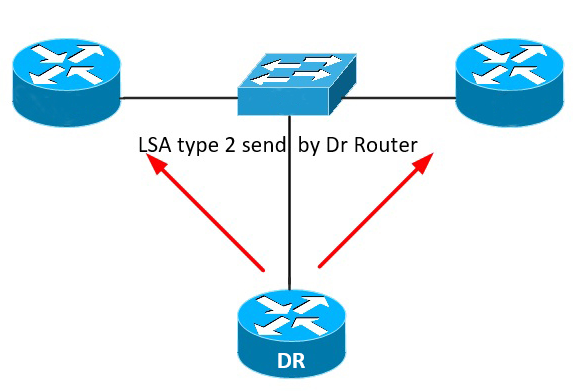Each router within the area will flood a type 1 router LSA within the area. In this LSA you will find a list with all the directly connected links of this router. How do we identify a link?
- The IP prefix on an interface.
- The link type. There are 4 different link types:
| Link Type | Description | Link ID |
| 1 | Point-to-point connection to another router. | Neighbor router ID |
| 2 | Connection to the transit network. | IP address of DR |
| 3 | Connection to the stub network. | IP Network |
| 4 | Virtual Link | Neighbor router ID |
The second LSA type (network-LSA) is created for multi-access networks:
OSPF AREA 0
The network-LSA or type 2 is created for each multi-access network. Remember the OSPF network types? The broadcast and non-broadcast network types require a DR/BDR. If this is the case you will see these network LSAs being generated by the DR. In this LSA we will find all the routers that are connected to the multi-access network, the DR and of course the prefix and subnet mask.Type 3
ype 1 router LSAs always stay within the area. OSPF, however, works with multiple areas and you probably want full connectivity within all of the areas. R1 is flooding a router LSA within the area so R2 will store this in its LSDB. R3 and R4 also need to know about the networks in Area 2.
R2 is going to create a Type 3 summary-LSA and flood it into area 0. This LSA will flood into all the other areas of our OSPF network. This way all the routers in other areas will know about the prefixes from other areas.
The name “summary” LSA is very misleading. By default, OSPF is not going to summarize anything for you. There is, however, a command that let you summarize inter-area routes. If you are looking at the routing table of an OSPF router and see some O IA entries you are looking at LSA type 3 summary LSAs. Those are your inter-area prefixes!
Type 4
In this example, we have R1 that is redistributing information from the RIP route into OSPF. This makes R1 an ASBR (Autonomous System Border Router). What happens is that R1 will flip a bit in the router LSA to identify itself as an ASBR. When R2 who is an ABR receives this router LSA it will create a type 4 summary ASBR LSA and flood it into area 0. This LSA will also be flooded in all other areas and is required so all OSPF routers know where to find the ASBR.
Type 5
Type 7
- Type 1 – Router LSA: The Router LSA is generated by each router for each area it is located. In the link-state ID you will find the originating router’s ID.
- Type 2 – Network LSA: Network LSAs are generated by the DR. The link-state ID will be the router ID of the DR.
- Type 3 – Summary LSA: The summary LSA is created by the ABR and flooded into other areas.
- Type 4 – Summary ASBR LSA: Other routers need to know where to find the ASBR. This is why the ABR will generate a summary ASBR LSA which will include the router ID of the ASBR in the link-state ID field.
- Type 5 – External LSA: also known as autonomous system external LSA: The external LSAs are generated by the ASBR.
- Type 6 – Multicast LSA: Not supported and not used.
- Type 7 – External LSA: also known as not-so-stubby-area (NSSA) LSA: As you can see area 1 is an NSSA (not-so-stubby-area) which doesn’t allow external LSAs (type 5). To overcome this issue we are generating type 7 LSAs instead..







No comments:
Post a Comment